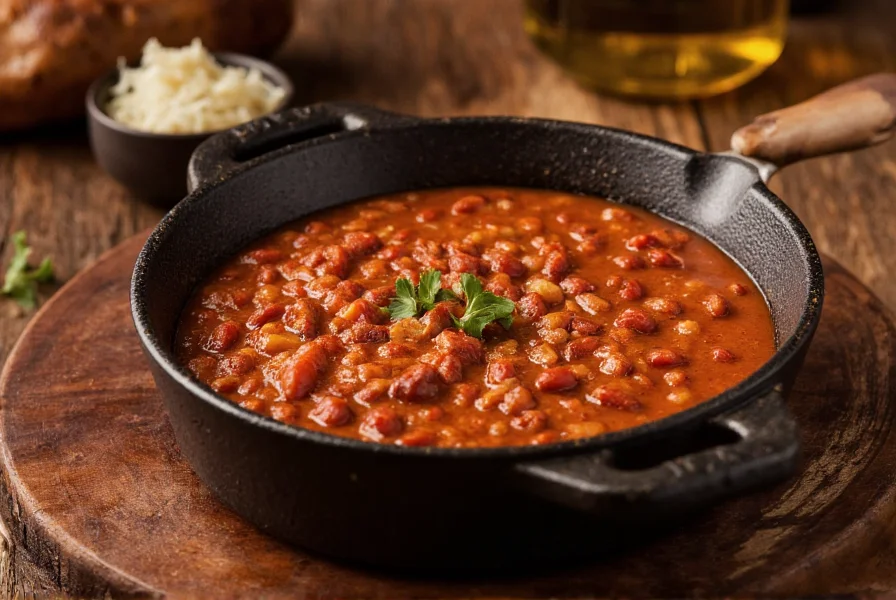When you're searching for what is boilermaker chili, you're likely looking for more than just another chili recipe. This regional specialty has deep roots in Midwest culinary tradition, particularly at Purdue University where it's become a beloved campus staple. Unlike standard chili recipes, boilermaker chili carries specific characteristics that make it uniquely suited to cold Indiana winters and game day celebrations.
The Historical Roots of Boilermaker Chili
The term 'Boilermaker' traces back to Purdue University's 1891 football team, nicknamed for their rugged, hardworking nature reminiscent of industrial boiler makers. While the exact origin of boilermaker chili remains somewhat debated among alumni, food historians generally agree it emerged in the 1950s-60s as a hearty meal for students during harsh Midwest winters.
Unlike Cincinnati chili (which is served over spaghetti) or Texas red (which contains no beans), authentic boilermaker chili represents a perfect middle ground—substantial enough for hungry students yet complex in flavor. The history of boilermaker chili is closely tied to Purdue's campus culture, with many fraternities and student organizations developing their own variations over the decades.

What Sets Boilermaker Chili Apart
While many chili recipes exist, boilermaker chili vs regular chili reveals several distinctive features:
| Feature | Boilermaker Chili | Standard Chili |
|---|---|---|
| Meat Base | Ground beef (sometimes with chuck roast) | Often cubed chuck roast |
| Beans | Kidney beans required | Bean inclusion varies by region |
| Signature Ingredient | Coffee or espresso powder | Rarely includes coffee |
| Texture | Thicker, heartier consistency | Can range from brothy to thick |
| Serving Tradition | Game days, campus events | Variety of occasions |
The inclusion of coffee is perhaps the most distinctive element in authentic boilermaker chili ingredients. This isn't for flavor alone—the acidity helps tenderize the meat while the bitterness balances the sweetness of tomatoes. Many Purdue alumni swear that skipping the coffee results in something that simply isn't true boilermaker chili.
Traditional Boilermaker Chili Recipe
Creating an authentic version requires attention to detail. This Purdue University chili recipe serves 8-10 and takes approximately 2.5 hours from start to finish:
Ingredients
- 2 lbs ground beef (80/20 blend)
- 1 large yellow onion, finely diced
- 4 cloves garlic, minced
- 2 (15oz) cans kidney beans, drained
- 1 (28oz) can crushed tomatoes
- 1 cup strong brewed coffee or 1 tbsp espresso powder
- 2 tbsp chili powder
- 1 tbsp cumin
- 1 tsp smoked paprika
- 1 tsp oregano
- 1/2 tsp cayenne pepper (adjust to taste)
- Salt and black pepper to taste
- 2 tbsp tomato paste
Preparation
- Brown ground beef in a large Dutch oven over medium-high heat, breaking into small crumbles
- Add onions and garlic, cooking until translucent (about 5 minutes)
- Stir in tomato paste and cook for 2 minutes to deepen flavor
- Add all spices and cook for 1 minute to toast the spices
- Pour in crushed tomatoes and coffee, stirring to combine
- Add kidney beans and bring to a gentle simmer
- Reduce heat to low, cover partially, and simmer for 2 hours, stirring occasionally
- Season with salt and pepper to taste before serving
For the most authentic experience, many Purdue alumni recommend making this traditional boilermaker chili preparation the day before serving, as the flavors deepen overnight. The chili should have a thick, hearty consistency that holds its shape when scooped—not too soupy, but not dry either.
Serving Traditions and Accompaniments
In true Midwest boilermaker chili tradition, this dish is rarely served alone. At Purdue, it's traditionally accompanied by:
- Freshly baked cornbread (often with a 'Boiler Gold' yellow color)
- Sliced jalapeños for those who want extra heat
- Shredded cheddar cheese
- Sour cream
- Finely diced white onions
The Purdue football game chili recipe variation often includes a 'Boiler Gold' spice mix—typically a blend of turmeric, mustard powder, and paprika that gives the chili a distinctive golden hue when served. This version is particularly popular during tailgating season.

Modern Variations and Adaptations
While purists insist on the traditional recipe, many contemporary cooks have developed creative adaptations of how to make boilermaker chili that maintain the spirit while accommodating modern tastes:
- Slow cooker method: After browning meat and sautéing aromatics, transfer everything to a slow cooker and cook on low for 6-8 hours
- Vegan version: Substitute ground beef with textured vegetable protein and use vegetable broth instead of coffee
- Game meat variation: Some Indiana hunters use venison instead of beef for a leaner option
- Spice level adjustments: Many families have their own 'heat scale' ranging from mild 'Boiler Warm' to fiery 'Boiler Burn'
Regardless of variations, the essence of genuine boilermaker chili remains its hearty, comforting nature—perfect for Indiana's cold months and embodying the resilient spirit of Purdue's campus community.
Why This Regional Specialty Endures
Unlike trendy food fads, boilermaker chili has maintained its popularity for decades because it delivers exactly what cold-weather comfort food should: warmth, substance, and a sense of community. The boilermaker chili tradition represents more than just a recipe—it's a culinary touchstone that connects generations of Purdue students and fans.
What makes this authentic boilermaker chili special isn't just the ingredients, but the context in which it's enjoyed. Whether served in dining halls, at tailgates, or in student apartments, it represents a shared experience that transcends mere sustenance. In today's fast-paced culinary landscape, such regionally significant dishes remind us of food's power to create and maintain community.
What makes boilermaker chili different from regular chili?
Boilermaker chili differs from regular chili primarily through its distinctive use of coffee or espresso powder, which adds depth and balances the acidity of tomatoes. It traditionally features ground beef rather than cubed meat, always includes kidney beans, and has a thicker consistency than many regional chili varieties. The spice profile also tends to be more balanced—neither as sweet as Cincinnati chili nor as intensely spicy as some Texas varieties.
Is boilermaker chili actually from Purdue University?
Yes, boilermaker chili is authentically associated with Purdue University in West Lafayette, Indiana. The name comes from Purdue's mascot and nickname 'Boilermakers,' which dates back to 1891. While the exact origin story varies among alumni, the chili became a campus staple in the mid-20th century and is traditionally served at football games, campus events, and student gatherings. Many Purdue-affiliated organizations have their own closely guarded versions of the recipe.
Can I make boilermaker chili without coffee?
While you can technically make a version without coffee, it wouldn't be authentic boilermaker chili. The coffee (or espresso powder) is a signature ingredient that provides depth of flavor and helps balance the acidity of the tomatoes. If you must omit it, substitute with an equal amount of strong brewed tea or additional beef broth, but note that many Purdue alumni consider coffee essential to the true boilermaker experience. The coffee doesn't make the chili taste like coffee—it simply enhances the other flavors.
What are traditional toppings for boilermaker chili?
Traditional toppings for authentic boilermaker chili include shredded cheddar cheese, sour cream, finely diced white onions, and sometimes sliced jalapeños for those who prefer extra heat. It's almost always served with cornbread—often yellow cornbread that references Purdue's 'Boiler Gold' school color. Some variations include a sprinkle of the special 'Boiler Gold' spice mix (typically containing turmeric) over the top before serving, especially during football season.
How long should boilermaker chili simmer for best results?
For optimal flavor development, traditional boilermaker chili should simmer for at least 2 hours after all ingredients are combined. Many Purdue alumni and campus chefs recommend making it the day before serving and refrigerating overnight, as the flavors continue to meld and deepen. When reheating, add a small amount of water or broth if needed to achieve the proper thick-but-scoopable consistency that characterizes authentic boilermaker chili.











 浙公网安备
33010002000092号
浙公网安备
33010002000092号 浙B2-20120091-4
浙B2-20120091-4